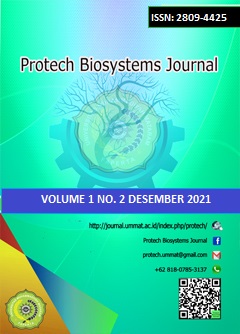Effect Of Raw Material Variation On Briquette Quality
DOI:
https://doi.org/10.31764/protech.v1i2.7031Keywords:
Briquettes, Alternative Energy, Material VariationAbstract
The main source of energy for humans is natural resources derived from fossils. Scarcity and rising oil prices will continue to occur due to its non-renewable nature. This must be immediately balanced with the provision of alternative energy sources that are renewable, abundant and cheap so that they are affordable by the wider community. The use of briquettes is based on the increasing price of petroleum in the global market. Charcoal briquettes are charcoal that is further processed into briquettes (special and more attractive appearance) that can be used for daily purposes. This study aims to determine the best raw materials in making quality briquettes. The method used in this research is an experimental method with experiments in the laboratory. The design used is a completely randomised design (CRD) consisting of 5 treatments as follows, P1: 100% corn cob, P2: 75% corn cob + 25% rice husk, P3: 50% corn cob + 50% rice husk, P4: 25% corn cob +75% rice husk and P5: 100% rice husk. Observation data were analysed using Anova (analysis of variance) at the 5% level. If there is a significant difference, then it is continued with the honest real difference test (BNJ) at the real level of 5%. The lowest value of water content was P5 which was 47.44%, in the stability of the smallest shape change was P1 4.0%, the least particle loss was P1 0.35% and the longest burning time was P3 at 113 minutes. Based on the research results, the best treatment is P3 where the moisture content value is 47.64%, with particle loss of 0.77%, and the longest burning time is 113 minutes.References
Arni L, Hosiana MD, Nismayanti A. 2014. Studi uji karakteristik fisis briket bioarang sebagai sumber energi alternatif. Journal of Natural Science. 3(1): 89-98.
Gandhi, A.B. 2010. Pengaruh Variasi Jumlah Campuran Perekat terhadap Karakteristik Briket Arang Tongkol Jagung, SMKN 7 Semarang, Semarang.
Gulhan Ozbayoglu, Kejhanak Rowshan Tabari. 2003. Briquetting of Iran-Angouran Smithsonite Fines, Physicochemical Problems of Mineral Processing, hal. 115-122.
Hambali, E.; Mujdalipah, S.; Tambunan, A.H.; Pattiwiri, A.W.; Hendroko, R. 2007. Teknologi Bioenergi, Agromedia Pustaka, Jakarta.
Hamidi, N.; Handono S. 2011. Pengaruh Penambahan Tongkol Jagung Terhadap Peforma Pembakaran Bahan Bakar Briket Blotong (Filter Cake), Jurnal Rekayasa Mesin, Jurusan Teknik Mesin Universitas Brawijaya, Malang, 2(2). 92-97.
Husada, T.I. 2008. Arang Briket Tongkol Jagung Sebagai Energi Alternatif, Laporan Hasil Penelitian Program Inovasi Mahasiswa Provinsi Jawa Tengah, Universitas Negeri Surakarta, Semarang.
Kadir, A. 2006. Energi: Sumber daya, Inovasi, Tenaga Listrik, dan Potensi Ekonomi, UI Press, Jakarta.
Kumar, P.S.; Ramakrishnan, K.; Kirupha, S.D.; Sivanesan, S. 2010. Thermodynamic and Kinetic Studies of Cadmium Adsorption from Aqueous Solution onto Rice Husk, Brazilian Journal of Chemical Engineering, 27(2), 347-355.
Kurniawan, O.; Marsono. 2008. Superkarbon; Bahan Bakar Alternatif Pengganti Minyak Tanah dan Gas, Penebar Swadaya, Jakarta.
Mangkau, A.; Rahman, A.; Bintaro, G. 2011. Penelitian Nilai Kalor Briket Tongkol Jagung dengan Berbagai Perbandingan Sekam Padi, Jurusan Teknik Mesin Fakultas Teknik Universitas Hasanuddin, Makassar.
Ndraha N. 2009. Uji komposisi bahan pembuat briket bioarang tempurung kelapa dan serbuk kayu terhadap mutu yang dihasilkan. Sumatera Utara: USU.
Patabang D. 2012. Karakteristik termal briket arang sekam padi dengan variasi bahan perekat. Jurnal Mekanikal. 2(3): 286-292.
Saputro, D. D., Widayat, W., & Rusiyanto, S. H. (2012, November). Fauzun (2012) Karakterisasi Briket dari Limbah Pengolahan Kayu Sengon Dengan Metode Cetak Panas. In Prosiding Seminar Nasional Aplikasi Sains & Teknologi (Snast) Periode III, Yogyakarta (Vol. 3).
Sarjono. 2013. Studi Eksperimental Perbandingan Nilai Kalor Briket Campuran Bioarang Sekam Padi dan Tempurung Kelapa, Majalah Ilmiah STTR Cepu, Jurusan Teknik Mesin, Cepu, 11(17), 11-18.
Setiowati, R. and Tirono, M. 2014. Pengaruh variasi tekanan pengepresan dan komposisi bahan terhadap sifat fisis briket arang. Jurnal Neutrino: Jurnal Fisika Dan Aplikasinya, 7(1), pp.23-31.
Sinurat, E. 2011. Studi Pemanfaatan Briket Kulit Jambu Mete dan Tongkol Jagung sebagai Bahan Bakar Alternatif, Tugas Akhir, Teknik Mesin, Universitas Hasanuddin, Makassar.
Subroto, H. D. Sartono. 2007. Pengaruh variasi tekanan pengepresan terhadap karakteristik mekanik dan karakteristik pembakaran briket kokas lokal Surakarta. Jurnal Teknik Gelagar, 18(1), 73-79.
Subroto. 2007. Karakteristik Pembakaran Briket Campuran Arang Kayu dan Jerami. Jurnal Media Mesin. Vol. 8 No. 1 (10-16).
Sucipto, C.D. 2012. Teknologi Pengelolaan Daur Ulang Sampah, Gosyen Publishing, Yogyakarta.
Sudiro, S. S. 2014. Pengaruh Komposisi dan Ukuran Serbuk Briket yang Terbuat dari Batubara dan Jerami Padi Terhadap Karakteristik Pembakaran, Politeknik Indonusa, Surakarta, 02(02).
Syamsiro, M. Dan Saptoadi, H. 2007." Pembakaran Briket Biomassa Cangkang Kakao: Pengaruh Temperatur Udara Preheat.
Widayat, W. 2008. Kajian Sifat Mekanis Briket Tongkol Jagung yang dikompaksidengan Tekanan Rendah. Jurnal Ilmiah Popular dan Teknologi Terapan, 6(2), 905-914.
Yusuf, Andi Ardan. 2010. Kegunaan Briket Batubara. Fakultas Teknologi Industri. Universitas Muslim Indonesia. Jakarta.
Downloads
Published
Issue
Section
License
Authors who publish articles in Protech Biosystems Journal agree to the following terms:
- Authors retain copyright of the article and grant the journal right of first publication with the work simultaneously licensed under a CC-BY-SA or The Creative Commons Attribution–ShareAlike License.
- Authors are able to enter into separate, additional contractual arrangements for the non-exclusive distribution of the journal's published version of the work (e.g., post it to an institutional repository or publish it in a book), with an acknowledgment of its initial publication in this journal.
- Authors are permitted and encouraged to post their work online (e.g., in institutional repositories or on their website) prior to and during the submission process, as it can lead to productive exchanges, as well as earlier and greater citation of published work (See The Effect of Open Access).

